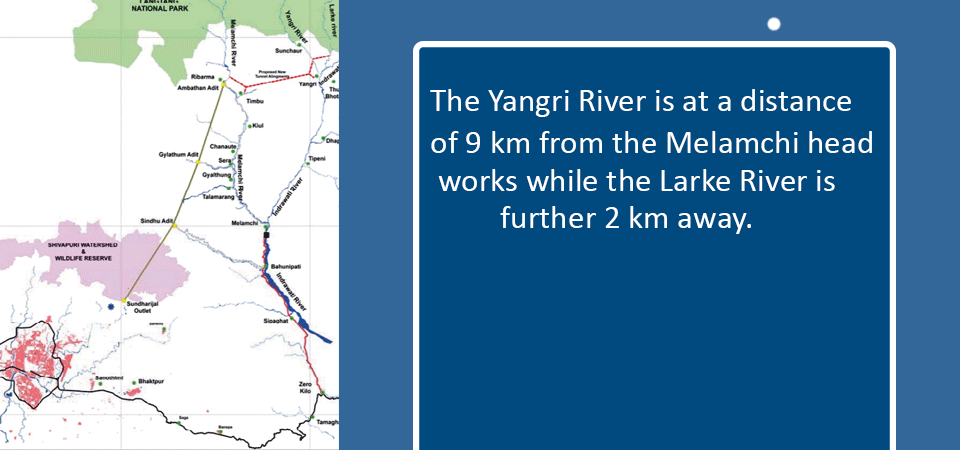Melamchi Phase II
Water from Yangri, Larke in four years

By Modnath Dhakal
Kathmandu, Apr. 25: The Melamchi Water Supply Project (MWSP) is set to bring water of Yangri and Larke rivers to the Kathmandu Valley within next four years.
About 340 million litres of water per day would be brought to the valley from the two rivers in Sindhupalchok district in the second phase of the MWSP in addition to the current 170 million litres per day (MLD) from the Melamchi River.
The Yangri River is at a distance of 9 km from the Melamchi head works while the Larke River is further 2 km away.
To bring the water down to the Melamchi River from Yangri and Larke rivers, a 9-km-long tunnel would be constructed up to Yangri while to connect Larke, a large tunnel with partition would be constructed. A part of the tunnel will be used for the vehicular movement, Executive Director of the project Tiresh Prasad Khatri said to The Rising Nepal.
He said that the procurement process for the construction services would be initiated by September this year. The second phase of the project is estimated to be completed within next four fiscal years – by 2024/25.
Meanwhile, speaking at the inauguration of water distribution from the national pride project at the Bhrikutimandap in Kathmandu earlier this month, Prime Minister KP Sharma Oli expressed confidence that the additional 340 MLD water would be brought to the valley in the next three years.
He had directed the Ministry of Water Supply to create conducive environment for adding water from the Yangri and Larke rivers to the supply channel by 2024.
Switching to TBM
"The Prime Minister has directed us to bring the additional water into the valley in three years. However, there could be a slight delay as the project is reviewing the method of the tunnel construction," said Khatri. Although study for the second phase of the project is complete and it is ready for execution, MWSP is mulling to switch to Tunnel Boring Machine (TBM) system from the earlier Drill and Blast Method (DBM).
TBM method has high productivity and cost saving benefits. It will save about 6-7 months in tunnel construction compared to the DBM, according to the experts. Likewise, it will save about Rs. 2 billion budget. "DBM would cost over Rs. 11 billion for the 11-km tunnel while TBM can bring it down to Rs. 9 billion," said Khatri.
However, these are preliminary estimates made on the basis of experts' opinion. The project is yet to revise the cost estimation according to the alternative technology to be adopted for the development of the project.
The first phase of the project has constructed about 26.5 km tunnel by adopting DBM. In Nepal, Bheri-Babai Diversion Multipurpose Project has adopted the TBM for the first time and achieved good results.
According to the MWSP, while DBM could drill about 4.5 metres (m) tunnel in a day, TBM can extend it up to 15 meters a day. In comparatively easier geological situations like at the Bheri-Babai project, TBM could bore as much as 30 m tunnel in a day.
Managing resources
According to Khatri, the project is yet to pool resources for the execution of phase-II of Melamchi.
The Asian Development Bank (ADB) has shown interest in funding the project. However, it wants to observe the water distribution system of the Melamchi water in the valley and its management. "But since it might delay the decision on the part of the donor, alternative sources will be sought," said Khatri.
ADB is the major donor of the MWSP first phase. Currently, the project is conducting dialogue with the local communities, building access roads, bridges and other facilities. Local people have demanded support in the construction of roads, schools and health facilities.
Additional facilities
The MWSP has constructed two Water Treatment Plants (WTPs) with the capacity of 85 MLD each at Sundarijal to purify the water before sending it to the distribution channel.
A total of 10 bulk distribution centres are developed across the valley. To treat the additional amount of water from Yangri and Larke, more WTPs should also be developed. The project said that the construction of the WTPs would move ahead simultaneously.
The project was conceived about four decades ago. The government had established Melamchi Water Supply Development Board in 1998 August under the erstwhile Ministry of Physical Planning. Initially, the project was expected to complete by 2007 but it could bring in water to the Valley after approximately 14 years in 2021.
Late Krishna Prasad Bhattarai, the then Prime Minister, about three decades ago after the restoration of democracy in 1990, had promised to bring the water of the Melamchi to the Kathmandu Valley.
Recent News

Do not make expressions casting dout on election: EC
14 Apr, 2022
CM Bhatta says may New Year 2079 BS inspire positive thinking
14 Apr, 2022
Three new cases, 44 recoveries in 24 hours
14 Apr, 2022
689 climbers of 84 teams so far acquire permits for climbing various peaks this spring season
14 Apr, 2022
How the rising cost of living crisis is impacting Nepal
14 Apr, 2022
US military confirms an interstellar meteor collided with Earth
14 Apr, 2022
Valneva Covid vaccine approved for use in UK
14 Apr, 2022
Chair Prachanda highlights need of unity among Maoist, Communist forces
14 Apr, 2022
Ranbir Kapoor and Alia Bhatt: Bollywood toasts star couple on wedding
14 Apr, 2022
President Bhandari confers decorations (Photo Feature)
14 Apr, 2022










